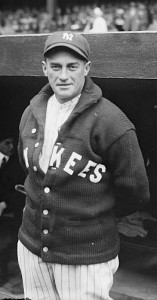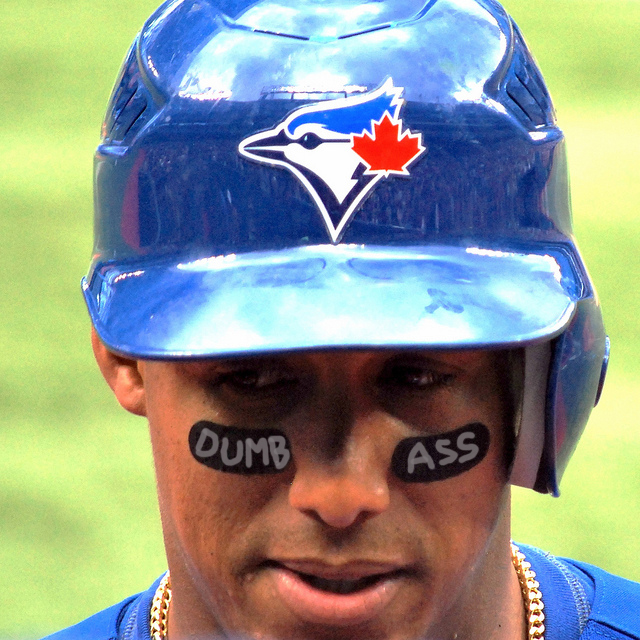All it took was a bit of photo editing to make his message correct.
The Unique Greatness of Mike Trout
As I’m sure you know, there are scores of internet writers who write exclusively about baseball, and dozens more who write about baseball in addition to other topics. To the best of my knowledge, none has written a word about Mike Trout this season.
In case you haven’t heard, Mike Trout is a rookie outfielder for the California Angels of Orange County, and he’s got a pretty good chance of winning the Rookie of the Year this year. In fact, if super slugger Miguel Cabrera hadn’t already locked up the AL MVP, we might be talking about Trout for that award as well. Click below to see why.
Stupid stuff from Monday’s games
Orioles 10, @Mariners 4: It’s the first time any team has scored 10+ runs at Safeco Field since 2011-08-30. The total of 14 runs is the 2nd-highest in Seattle this year, and is more than twice the season average of 6.32 R/G. That would be the lowest combined home scoring average for any MLB team that employed the designated hitter. In the live-ball era, just 23 teams have had lower averages at home, 6 of those in 1968.
- Pop quiz: Since 1901, what team had the lowest average Runs Allowed at home in a season? (Hint and answer at bottom of post.)
- Continue reading
Let’s Talk About Urban Shocker

Urban Shocker (image via Wikipedia)
So far, I’ve asked you to talk about Thurman Munson and David Cone. Today, I want to chat about a player who I see as something of a combination between the two—Urban Shocker.
Like Cone, Shocker was an elite starting pitcher who failed to win 200 games. Like Cone, this probably cost Shocker induction to the Hall of Fame. But like Cone, Shocker was so good during his peak that he just might deserve induction anyway.
Like Munson, Shocker died prematurely while still an active player. Like Munson, Shocker was still producing at a high level. While he had already turned 37, Shocker clearly had something left (in his final season, he went 18–6 with a 2.84 ERA, 137 ERA+, and 2.4 WAR). Shocker died in 1928 (less than a year after his 1927 Yankees won the World Series) of a weakened heart caused by pneumonia. He had suffered from a congenital heart problem for a while and reportedly hadn’t slept lying down in two years.
Shocker’s first season as a pitcher was also his first professional season (he was a catcher before then). Shocker pitched four minor league seasons north of the border in Ontario before being drafted by the Yankees in September of 1915. He was already about to turn 25 years old. His late start and his early death did not give him much time to leave his mark on the game.
But he certainly left a his mark. Continue reading
Nerves of Steal
The stolen base. Arguably one of the most exciting parts of a game: The runner weighs his perceived speed against the combination of the pitcher’s concern with holding the runner and the strength of the catcher’s arm. Many MLB greats have used the stolen base as an auxiliary part of a highly successful career (Joe Morgan, Roberto Alomar, etc.), whereas other players lived by, died by and built a whole career around it (Vince Coleman).
Evaluating the effectiveness of a stolen base has been a growing process, from Pete Palmer’s claim about 30 years ago that a SB gave a team 0.3 runs, whereas a CS was worth -0.6 runs, to Tom Tango’s more precise 0.18/-0.43 values. The latter is what we’re using here today. These values state that, on average, a CS is 2.39 times more detrimental than a SB is helpful, meaning that a runner needs to successfully steal 70.5% of the time to merely break even.
Flashback: J.R. Richard
One of my favorite things to do is to sit and talk about players from the 50’s, 60’s and 70’s with my father. He’s the reason I became such a big baseball fan in the first place and the amount of information he knows about these players is extraordinary.
For instance, I could name a random player whose name I just happened to have seen tweeted – more than likely by Andy – and my dad will know what position he played, which side he batted from or pitched from, depending on the player and will rattle off all the teams he played for. He’ll even mention if they were traded and who they were traded for. Sometimes I sit there with my mouth agape because of his ability to know that much about guys who haven’t played – in some cases – in fifty years.
This was the case a few days ago when we were watching one of those MLB Network Countdown shows together. The one we caught was a countdown of the Top 30 Most Intimidating Players. Players that all baseball fans know like David Ortiz, Nolan Ryan, Darryl Strawberry and Mariano Rivera were on the list. In fact, I knew all 30 players except for one.
When they got to number eight, the name wasn’t ringing a bell at all. Most of the people on the list are Hall of Famers, will be Hall of Famers or just missed being Hall of Famers. Of course, when my dad saw J.R. Richard appear on the screen, he said, “I remember J.R. Richard! He threw a 98 m.p.h. slider!” I gasped at the thought of a 98 m.p.h. slider, wondered if my dad was actually remembering correctly and then laughed at him for being a diehard Yankee fan who remembered a guy who played for the Houston Astros from 1971-1980.
Why does CC Sabathia allow so many unearned runs?
Fielding in baseball (if not fielders, necessarily) is getting better all the time. Improvements in equipment, field conditions and, especially, defensive positioning, mean today’s players have a leg up on their predecessors. Indeed, today’s computer analysis of batter and pitcher tendencies is of a sophistication unimagined even as recently as a decade ago. And, to top it off, recent years have seen progressively fewer balls in play due to ever increasing numbers of strikeouts. The end result – fewer errors and fewer unearned runs.
Nevertheless, unearned runs haven’t disappeared entirely and some pitchers seem to allow more of them than others. As an example, these are the starting pitchers of 2012 (min. 150 IP) with the three highest ratios of unearned runs allowed to total runs allowed.
| Rk | Player | R | ER | IP | Year | Age | Tm | G | GS | CG | SHO | W | L | BB | SO | HR | |||
|---|---|---|---|---|---|---|---|---|---|---|---|---|---|---|---|---|---|---|---|
| 1 | C.J. Wilson | 93 | 78 | 188.0 | 2012 | 31 | LAA | 31 | 31 | 0 | 0 | 12 | 9 | .571 | 80 | 159 | 3.73 | 101 | 17 |
| 2 | CC Sabathia | 85 | 71 | 176.0 | 2012 | 31 | NYY | 25 | 25 | 2 | 0 | 13 | 6 | .684 | 40 | 169 | 3.63 | 115 | 21 |
| 3 | Aaron Harang | 82 | 69 | 164.0 | 2012 | 34 | LAD | 28 | 28 | 0 | 0 | 9 | 9 | .500 | 77 | 123 | 3.79 | 101 | 14 |
Surprised? I mean those are all pretty decent pitchers. Why would it be those guys? After the jump, I’ll explain why perhaps this shouldn’t be so surprising.
Sunday notes (non-pennant-race edition)
I’m too glum about Detroit’s loss to cover the races, so here’s some stupid stuff instead:
Teenage Dream: Youngsters in the Baseball Post-Season
The Nationals have 89 wins going into tonight’s game against the Braves. The most wins any second wild-card in the NL can reach after 162 games is now 92 wins. So Washington needs just four more wins to ensure at least a wild-card game post-season spot.
The Nats in the playoffs would mean that, barring any late injury, Bryce Harper will become the eleventh teenager to appear in an MLB post-season game. Harper turns 20 on October 16, which according to the National League schedule will be a couple of games into the NLCS. A listing of the ten kids who Bryce Harper is seeking to join as teenage post-season participants is after the jump. Continue reading
Saturday snippets
@Dodgers 4, Cardinals 3: Twice down to their last strike, LA rallied to tie on Andre Ethier‘s single and a double by Friday’s hero, Luis Cruz — then won it when pinch-hitter Juan Rivera‘s soft liner slipped free of Daniel Descalso‘s leather. And so the second wild card race, between the lame and the halt, is tied at 76-70.

